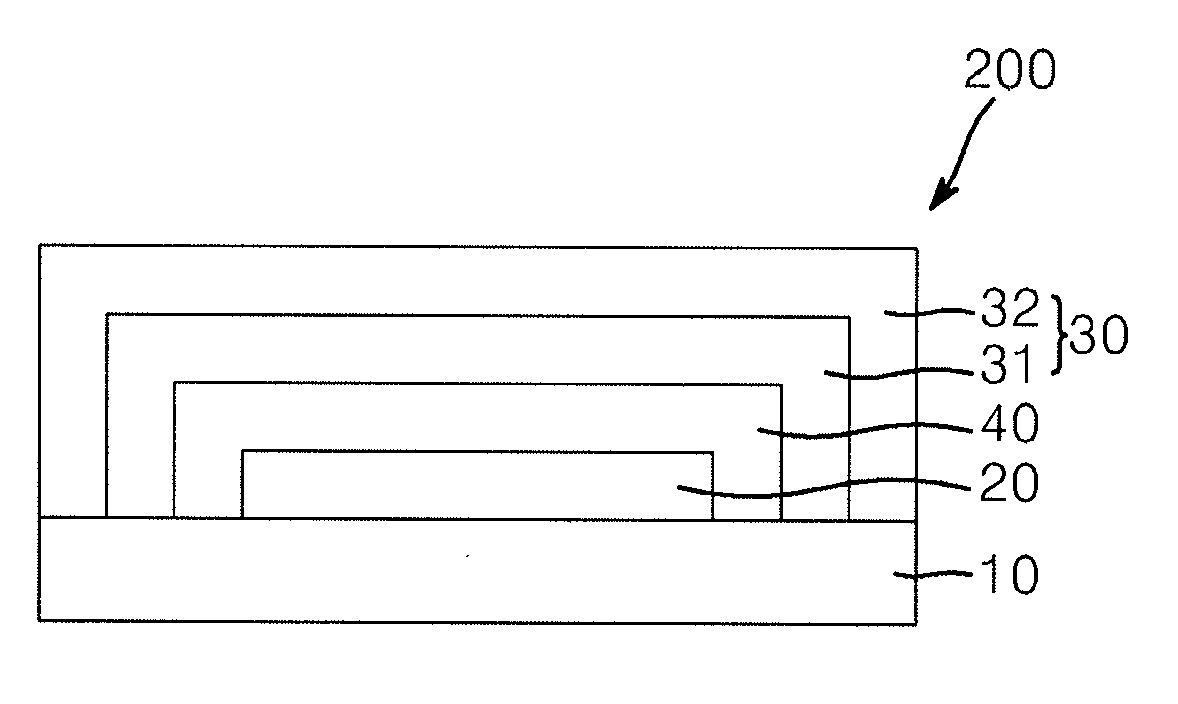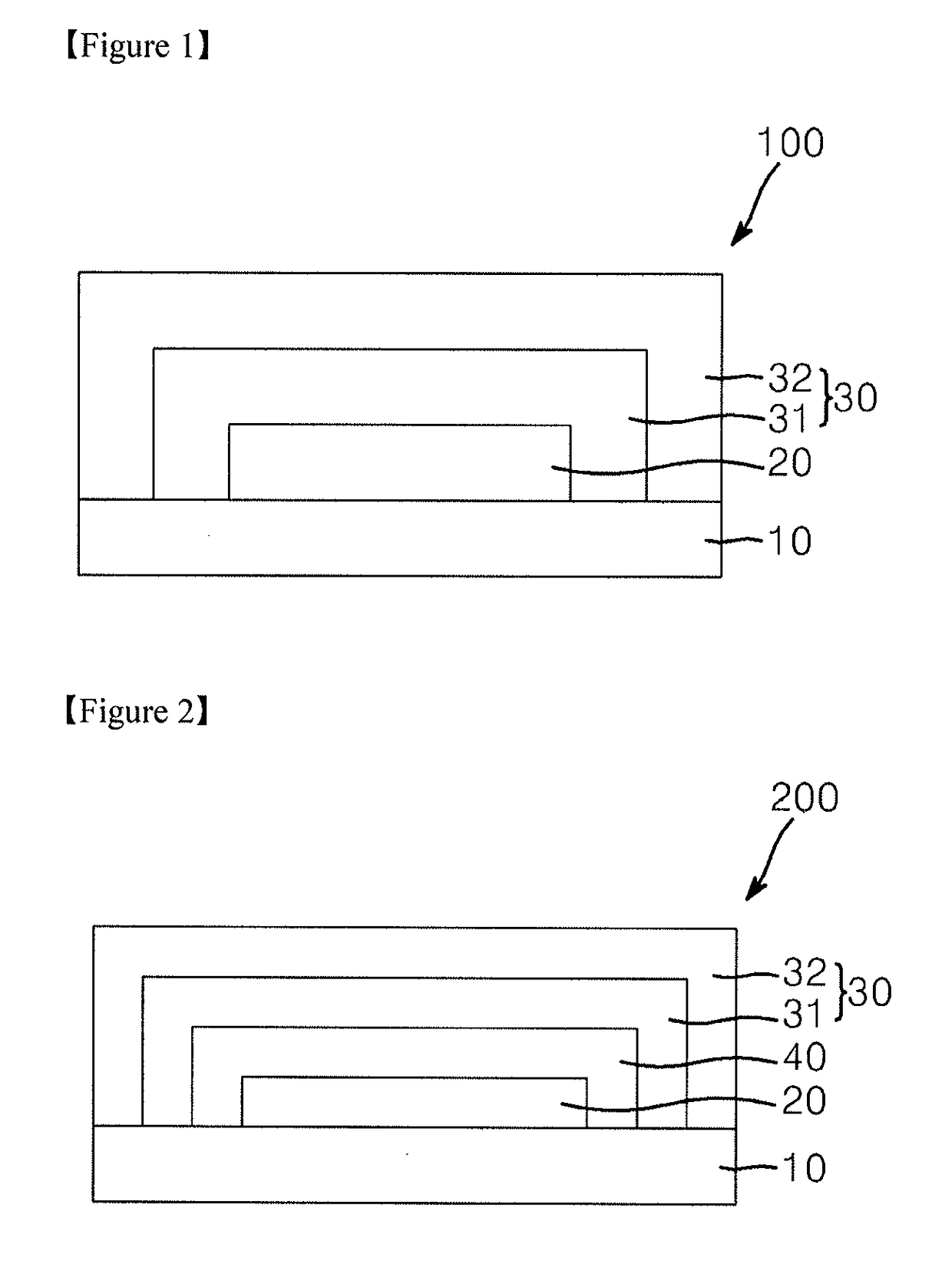Composition for display sealing material, organic protection layer comprising same, and display device comprising same
a technology of display sealing material and organic protection layer, which is applied in the direction of organic chemistry, organic semiconductor devices, coatings, etc., can solve the problems of high resistance, moisture or gas, degradation or deterioration of the properties of organic electroluminescent devices used in optical display apparatuses, etc., and achieves excellent transparency, low moisture permeation, and high plasma resistance
- Summary
- Abstract
- Description
- Claims
- Application Information
AI Technical Summary
Benefits of technology
Problems solved by technology
Method used
Image
Examples
example 2
Preparative Example 2
[0120]To a 2000 ml flask equipped with a cooling pipe and a stirrer, 600 ml of dichloromethane (manufacturer: Sigma-Aldrich) was charged, 58.8 g of hydroxyethyl methacrylate (Sigma-Aldrich) and 52.2 g of triethylamine (Sigma-Aldrich) were added while stirring at 0° C. and 100 g of triphenyl chloromethane (Sigma-Aldrich) was slowly added. After the temperature in the flask was allowed to increase to 25° C., the solution was stirred for 4 hours. Then, dichloromethane was removed by a vacuum distillation and the solution was subjected to a chromatography through a silica gel column to obtain a compound of formula 6 (124 g) having a purity of 97% as determined by HLPC.
example 3
Preparative Example 3
[0121]To a 2000 ml flask equipped with a cooling pipe and a stirrer, 800 ml of acetonitrile (Fisher) was charged, 180 g of potassium carbonate (Aldrich) and 108 g of acrylic acid were added while stirring at 0° C., and 150 g of 4,4′-bis(chloromethyl) biphenyl (TCI) was slowly added. After the temperature in the flask was allowed to increase to 70° C., the solution was stirred for 12 hours. Then, acetonitrile was removed by a vacuum distillation and the solution was subjected to a chromatography through a silica gel column to obtain a compound of formula 7 (177 g) having a purity of 97% as determined by HLPC.
example 4
Preparative Example 4
[0122]To a 3000 ml flask equipped with a cooling pipe and a stirrer, 300 ml of dichloromethane (Sigma-Aldrich) was charged, 200 g of hydroxylethyl acrylate (Shin-Nakamura Chemical Co., Ltd.) and 168 g of trimethylamine were added. After the temperature in the flask was allowed to decrease to 0° C., the solution in which 278 g of p-toluene sulfonyl chloride (Sigma-Aldrich) was dissolved in 500 ml of dichloromethane was drop-wise added for 2 hours while stirring. After stirring for 5 hours again, the remaining solvent was removed by distillation. 300 g of the obtained compound was added to 1000 ml of acetonitrile (Sigma-Aldrich), and 220 g of potassium carbonate (Sigma-Aldrich) and 141 g of 2-phenylphonol (Sigma-Aldrich) were added again, and stirred at 80° C. Then, the remaining solvent and the reaction residues were removed to obtain a compound of formula 8 (molecular weight 296.36) having a purity of 93% as determined by HLPC.
PUM
| Property | Measurement | Unit |
|---|---|---|
| roughness | aaaaa | aaaaa |
| weight average molecular weight | aaaaa | aaaaa |
| resistance | aaaaa | aaaaa |
Abstract
Description
Claims
Application Information
 Login to View More
Login to View More - R&D
- Intellectual Property
- Life Sciences
- Materials
- Tech Scout
- Unparalleled Data Quality
- Higher Quality Content
- 60% Fewer Hallucinations
Browse by: Latest US Patents, China's latest patents, Technical Efficacy Thesaurus, Application Domain, Technology Topic, Popular Technical Reports.
© 2025 PatSnap. All rights reserved.Legal|Privacy policy|Modern Slavery Act Transparency Statement|Sitemap|About US| Contact US: help@patsnap.com



